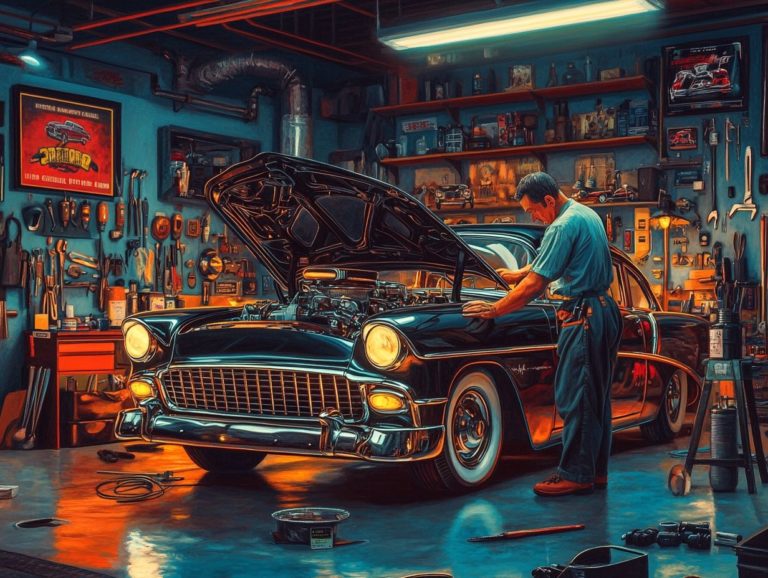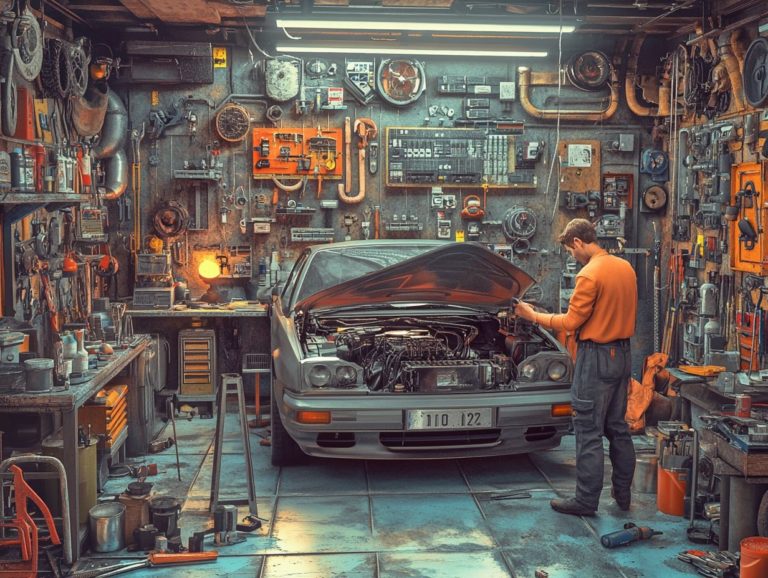How to Maintain Your Car’s Transmission
Your car s transmission is an essential part that often slips under the radar until something goes wrong. Understanding the various types of transmissions and their functions is vital for you as a driver.
This guide will walk you through common signs of transmission problems, provide maintenance tips, and highlight driving habits that can extend its lifespan. It also covers typical repairs and associated costs, so you ll be fully prepared to keep your vehicle operating seamlessly.
Explore this information to master the art of maintaining your car s transmission effectively!
Contents
- Key Takeaways:
- Understanding Your Car’s Transmission
- Signs of Transmission Problems
- Maintenance Tips for Your Transmission
- Driving Habits that Affect Your Transmission
- Common Transmission Repairs and Costs
- Extending the Lifespan of Your Transmission
- Frequently Asked Questions
- What are the signs that my car’s transmission needs maintenance?
- How often should I maintain my car’s transmission?
- What are some tips for maintaining my car’s transmission?
- Can I maintain my car’s transmission on my own?
- How much does it cost to maintain a car’s transmission?
- What happens if I don’t maintain my car’s transmission?
Key Takeaways:
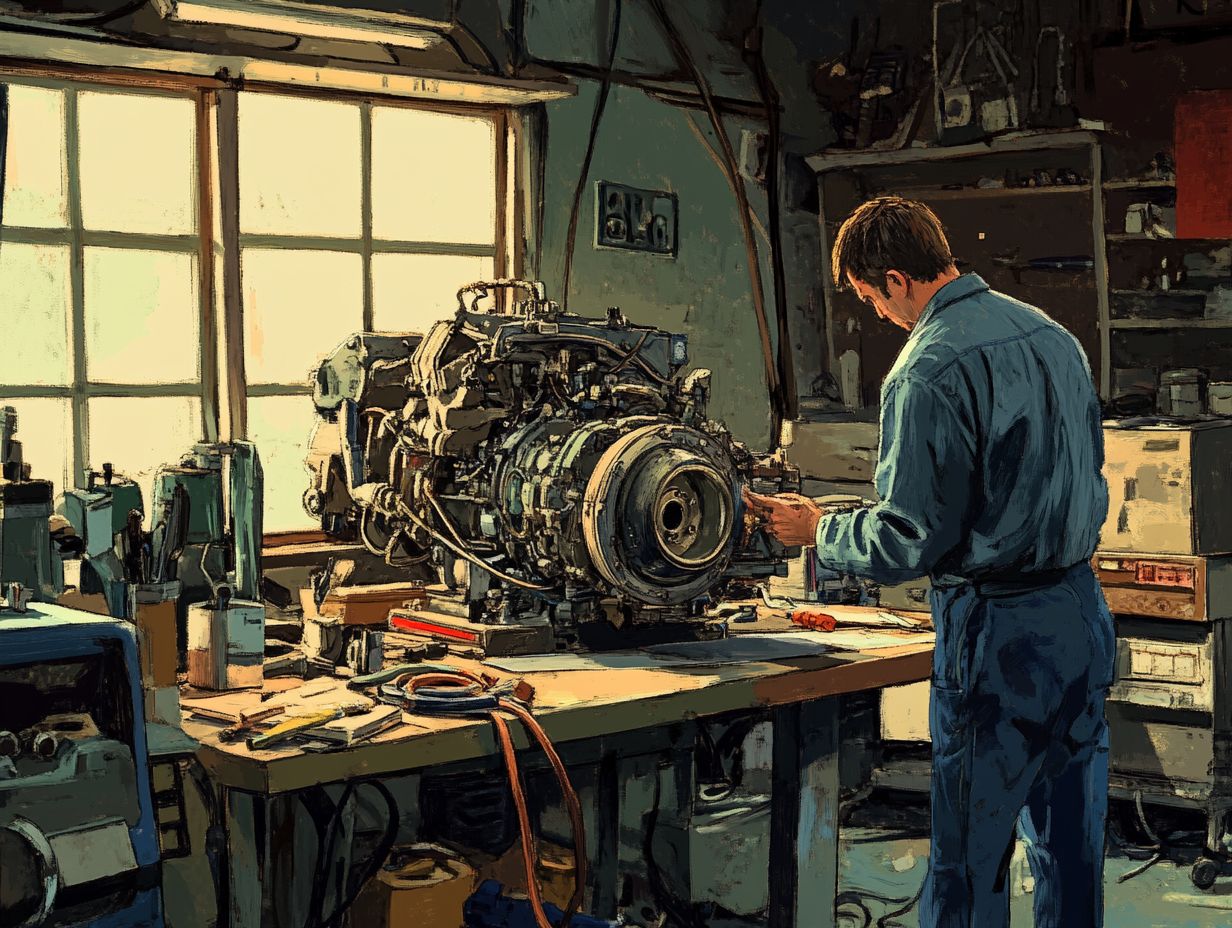
- Understand the type of transmission in your car and how it works to better maintain it.
- Recognize the signs of transmission problems and address them promptly to avoid costly repairs.
- Stick to a regular maintenance schedule and follow best driving practices to prolong the lifespan of your transmission.
Understanding Your Car’s Transmission
Understanding your vehicle’s transmission is essential for both its performance and longevity. The transmission acts as a key player, ensuring seamless gear shifts and allowing the engine to operate at its best.
In the case of automatic transmissions, transmission fluid is critical. It provides lubrication, cooling, and hydraulic pressure.
By committing to regular maintenance and inspections at reputable workshops like Mister Transmission or Ron s Auto & RV, you can sidestep potential costly repairs in the future, keeping your vehicle running smoothly for years ahead.
Types of Transmissions and How They Work
There are various types of transmissions, but the automatic transmission reigns as the most prevalent in modern vehicles, expertly engineered to shift gears effortlessly based on driving conditions.
This advanced system not only ensures smooth gear changes but also elevates overall vehicle performance, allowing you to concentrate fully on the road ahead.
Key components of an automatic transmission include the torque converter and transmission fluid. The hydraulic systems are responsible for the movement and pressure of the fluid, which helps in gear shifting. The torque converter is vital for transferring power from the engine to the transmission, while the hydraulic systems manage the flow of transmission fluid, which is essential for both lubrication and cooling.
Regular inspections of these components are paramount for preserving your vehicle’s reliability and efficiency on the road.
Signs of Transmission Problems
Recognizing the signs of transmission problems is essential for maintaining your vehicle’s performance and avoiding the costly repairs that can arise from overlooking these issues.
By paying attention to any unusual sounds, slipping gears, or fluid leaks, you empower yourself to address potential problems before they escalate, ensuring your vehicle operates smoothly and efficiently.
Identifying Common Issues
Common transmission issues can range from minor leaks to severe mechanical failures that demand your immediate attention to prevent further damage.
For example, if you notice puddles forming under your vehicle, it could signal a seal or gasket failure due to fluid leaks. Overheating may present itself through warning lights on your dashboard or even unusual burning smells that are hard to ignore. You might also find it challenging to shift gears one of those symptoms that could spiral into more significant problems if left unchecked.
To keep your transmission in top shape, make it a habit to regularly check the fluid levels and their condition, and keep an eye out for any signs of leaks or damage. If these issues persist or if your vehicle starts producing unfamiliar sounds or behaves oddly, seeking professional repair becomes essential to ensure your transmission’s longevity.
Maintenance Tips for Your Transmission

Proper maintenance is essential for prolonging the life of your transmission. Additionally, understanding how to maintain your car’s fuel system can help ensure smooth operation and significantly reduce the risk of costly repairs or unexpected breakdowns.
Ready to keep your transmission in top shape? Start by scheduling a maintenance check today!
Regular Maintenance Schedule
Establishing a regular maintenance schedule for your vehicle’s transmission is crucial for ensuring optimal performance and extending its lifespan. Aim to check the fluid levels at least once a month to keep everything running smoothly. Additionally, doing a careful check every 30,000 miles is wise; this proactive approach can help identify potential issues before they develop into expensive repairs.
This routine not only ensures that the transmission operates efficiently but also enhances your vehicle s overall longevity. Prioritizing the manufacturer’s recommendations is essential, as these guidelines are designed specifically for your model. They often include valuable service tips that can significantly reduce wear and tear, allowing you to enjoy a well-maintained vehicle for years to come.
Fluid and Filter Changes
Changing the transmission fluid and filter is an essential step in keeping your vehicle healthy. It greatly influences the health and performance of your transmission system.
By regularly servicing these components, you can prevent excessive wear, overheating, and avoid costly repairs down the line. Ideally, aim to have this service performed every 30,000 to 60,000 miles, though it s always prudent to consult your owner’s manual for specific recommendations.
Be on the lookout for signs that the fluid might need changing, such as:
- A burnt smell
- Irregular shifting
- Unusual noises during gear changes
Regarding selecting the right fluid and filters, ensure you choose products that meet the manufacturer’s specifications. This attention to detail will help guarantee optimal performance and longevity for your vehicle.
Driving Habits that Affect Your Transmission
Your driving habits significantly impact the longevity and performance of your vehicle’s transmission. It’s crucial to embrace practices that promote its well-being and ensure its optimal functioning.
Best Practices for Preserving Transmission Health
Adopting best practices for preserving your transmission’s health can significantly enhance its performance and reduce the risk of costly repairs. For those with older vehicles, learning how to maintain a car with high mileage and incorporating specific driving habits is key to this effort.
For instance, when you avoid rapid acceleration, you not only boost fuel efficiency but also relieve some of the strain on your transmission components.
Smoothly transitioning between gears, especially during shifts, creates a seamless flow of power, further extending the life of your transmission. Regularly checking your transmission fluid levels can help prevent overheating and ensure optimal performance.
Monitor the fluid quality for signs of contamination or discoloration, as these issues may point to underlying problems that require immediate attention. Taking these steps will safeguard your transmission and keep your vehicle running smoothly for the long haul.
Common Transmission Repairs and Costs
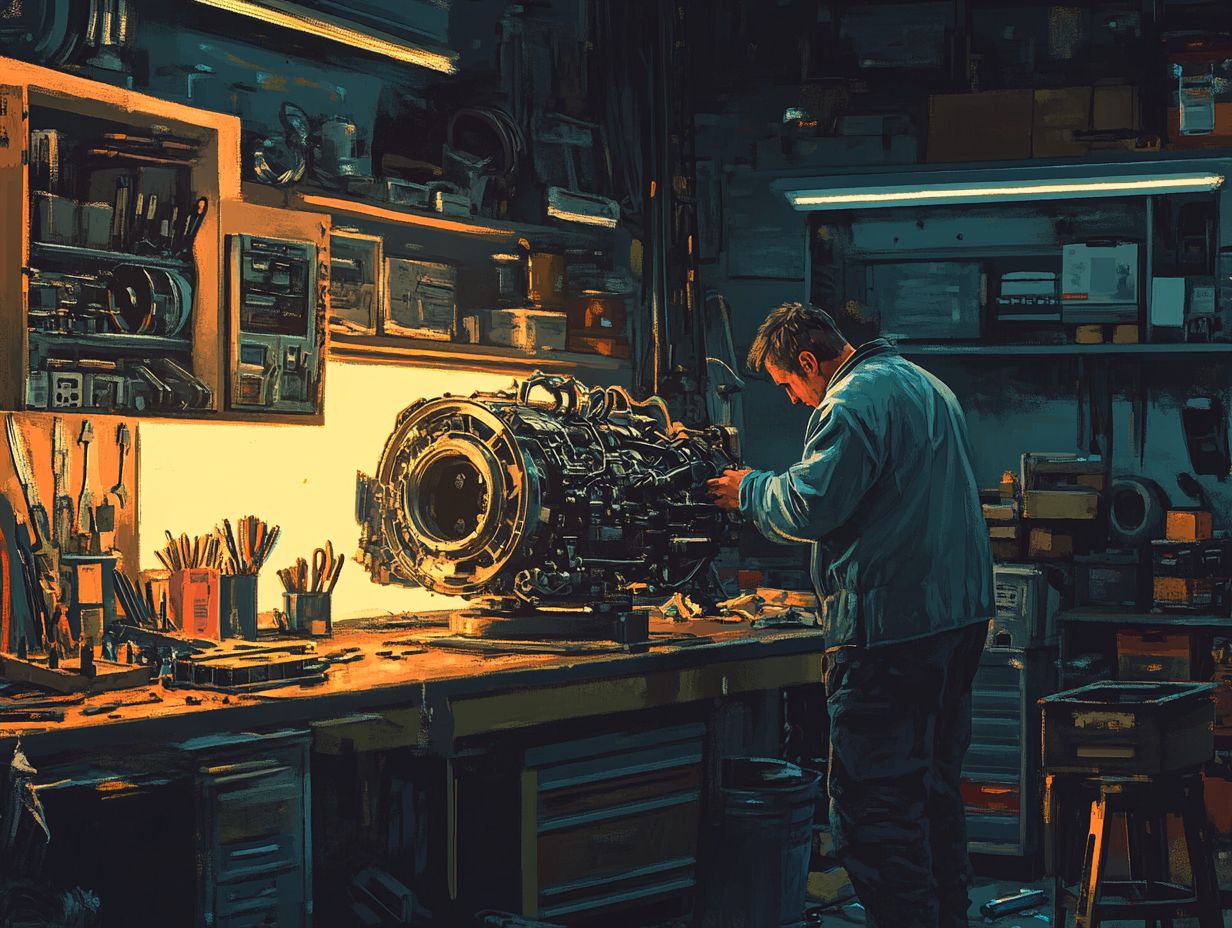
Grasping the nuances of common transmission repairs and their associated costs gives you the power to effectively plan for maintenance, allowing you to sidestep unexpected expenses in the future.
What to Expect When Repairs are Needed
When you find yourself needing transmission repairs, it s vital to understand what lies ahead in terms of the process, potential costs, and the timeline for completion.
Your journey begins with a comprehensive diagnostic assessment, where the technician meticulously examines your vehicle s transmission system for any faults. This initial step is crucial, as it helps pinpoint the specific issues that need addressing before any repair work can commence.
Following the diagnosis, you ll receive a detailed estimate that factors in the cost of parts and labor. Keep in mind that elements such as your vehicle’s make and model, the availability of parts, and the complexity of the repair can all influence both the projected timeline and the final cost.
Choosing a reliable service provider is essential. Their expertise not only guarantees quality repairs but also streamlines the entire process, helping to minimize both your downtime and expenses.
Extending the Lifespan of Your Transmission
Extending the lifespan of your transmission hinges on a thoughtful blend of excellent driving habits, consistent maintenance, and prompt repairs to address any issues before they escalate.
By adopting these practices, you can significantly enhance the longevity and performance of your transmission. This ensures a smoother ride for years to come.
Simple Tips to Keep Your Transmission Healthy
Maintaining your transmission in optimal condition is achievable with a few straightforward tips centered on maintenance and vigilance regarding potential issues, just as it’s important to know how to maintain your car’s cooling system.
Always check your fluid levels. Low transmission fluid can cause overheating and serious damage. Being mindful of driving conditions is equally important. Avoid excessive idling, harsh acceleration, and frequent short trips to greatly extend the life of your transmission.
Be alert for any unusual noises, slipping gears, or warning lights on your dashboard. These could indicate the need for professional assistance. Implementing these proactive measures will help you manage your vehicle’s health and steer clear of costly repairs.
Frequently Asked Questions
Here are some common questions about transmission maintenance:
What are the signs that my car’s transmission needs maintenance?
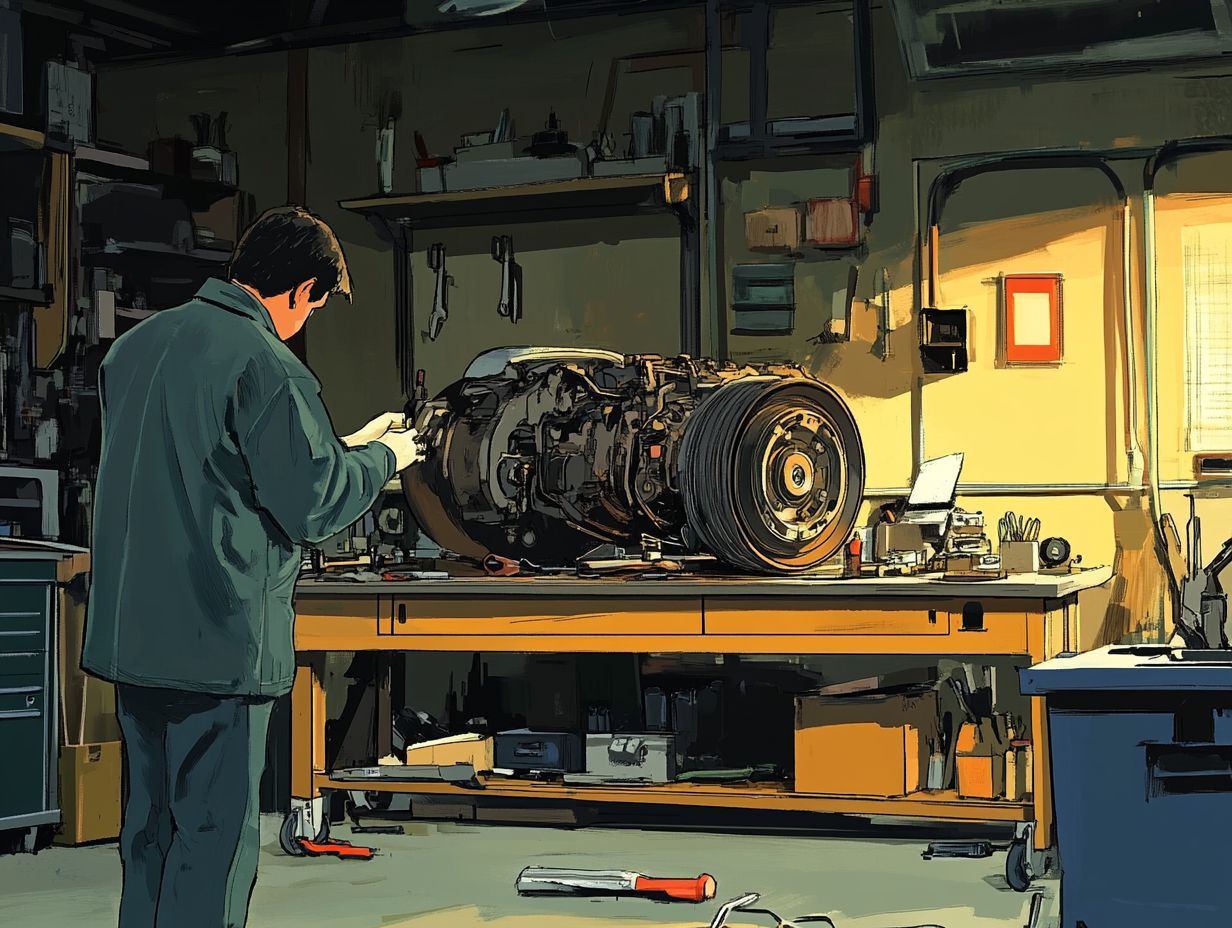
Some signs that your car’s transmission needs maintenance include:
- Strange noises or vibrations while shifting gears
- A burning smell
- Leaking fluid
- Difficulty shifting gears
How often should I maintain my car’s transmission?
Don’t wait! Maintain your car’s transmission every 30,000 to 60,000 miles to keep it running smoothly.
What are some tips for maintaining my car’s transmission?
Some tips include:
- Regularly checking and changing the transmission fluid
- Avoiding aggressive driving
- Getting your transmission flushed every few years
Can I maintain my car’s transmission on my own?
While some basic maintenance tasks can be done by yourself, it’s best to have a professional mechanic handle more complex transmission maintenance to ensure it’s done correctly.
How much does it cost to maintain a car’s transmission?
The cost can vary, but on average, it ranges from $100 to $300 depending on the type and extent of maintenance needed.
What happens if I don’t maintain my car’s transmission?
If you neglect to maintain your car’s transmission, it can lead to bigger and more expensive problems down the line, such as transmission system failure and the need for a costly replacement.
Don t let transmission issues sneak up on you! Regular checks can save you money and hassle.

